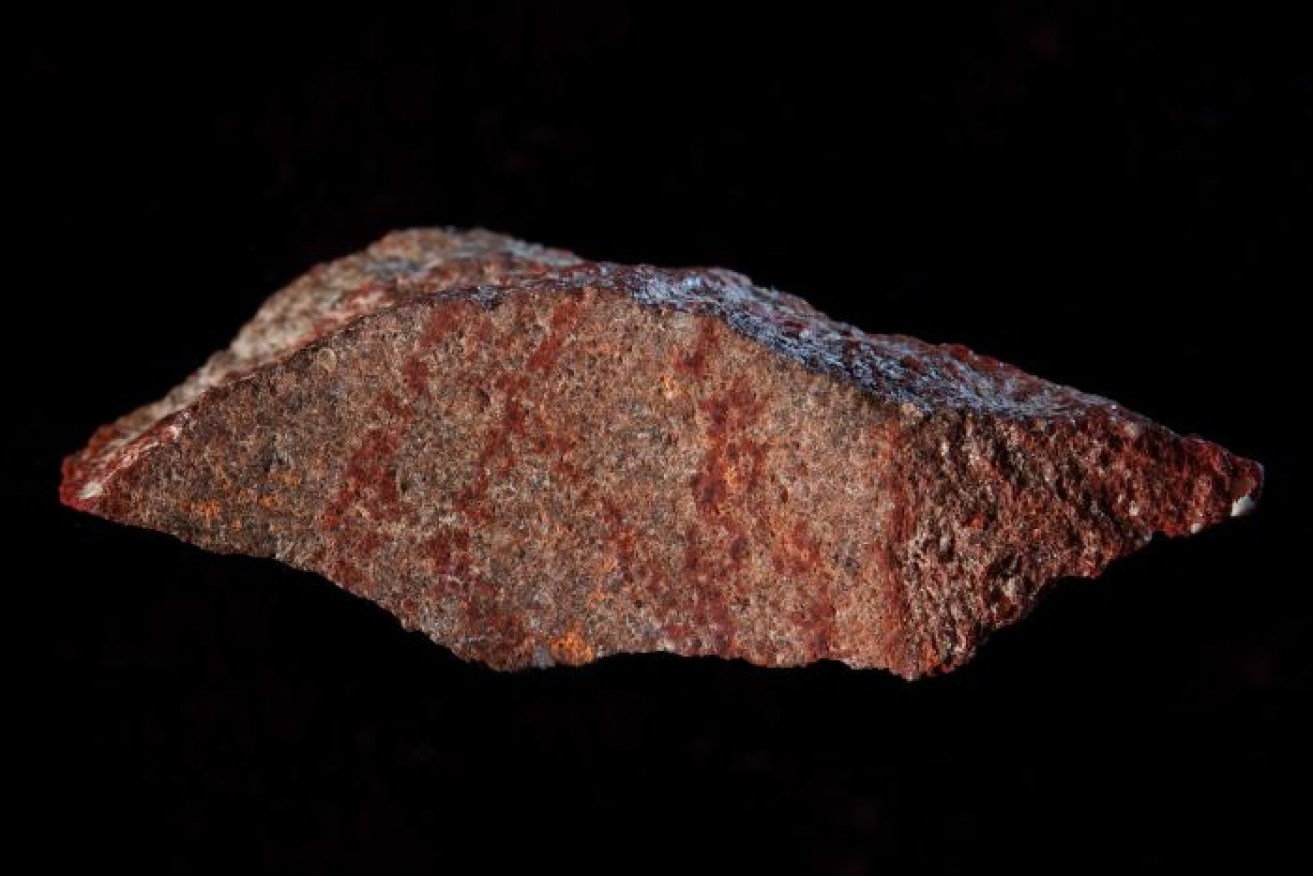Oldest-known drawing made by Stone Age humans in Africa

Experiments indicate these red marks were made by modern humans more than 70,000 years ago. Photo: AAP
The hashtag may be a symbol of modern communication, but humans have been drawing the cross-hatch design for at least 73,000 years.
That’s the conclusion of a team of archaeologists who’ve unearthed a stone flake criss-crossed by red ochre in Blombos Cave in South Africa.
“There’s no doubt it’s a drawing, and it’s been drawn deliberately,” said Christopher Henshilwood of the University of Bergen in Norway. “It’s not accidental.”
He said the latest discovery, reported today in the journal Nature, builds the case that early people of our kind, Homo sapiens, were capable of symbolic behaviour early in modern human history.
Until now, the earliest accepted symbolic ochre designs by modern humans were a red dot in El Castillo Cave in Spain dated to around 41,000 years, and a 40,000-year-old hand stencil and depiction of a “pig deer” in a cave in Sulawesi.
Blombos Cave sits on the southern Cape Coast, 300 kilometres east of Cape Town.
Modern humans have inhabited the cave, which overlooks the Indian Ocean, on and off for at least the past 100,000 years.
Professor Henshilwood and his team have been excavating the site for more than 20 years, and in that time they’ve uncovered a rich record of early modern human life.
They’ve found ochre engraved with cross-hatch designs, and a painting tool kit consisting of ochre, seal bone, and charcoal point in the deepest layers.
The cross-hatched flake came from a different layer, dated to around 73,000 years. This layer had also previously been found to contain cross-hatched engraved ochre, along with tools refined by a heating process, bone spear points and shell beads.

Blombos Cave in South Africa has been home to modern humans for at least 100,000 years. Photo: ABC/Magnus Haaland
But while there has been evidence the humans in the cave painted, engraved and made jewellery, the question was: did they draw?
“We found crayons at the site, but we didn’t know what they used them for, and now we’ve found this drawing,” Professor Henshilwood said.
The tiny flake, which is about the size of two thumbnails, is thought to have been chipped off a larger piece such as a grindstone.
Covered in ash and dirt, the pattern was revealed on the smooth face of the flake when it was washed under a tap.
Three lines running in one direction are crossed by six lines going in the other direction.
“The drawing that is on [the stone flake] would have been bigger,” Professor Henshilwood said. “It would have extended on to the rest of the grindstone, or at least part of the rest of the grindstone.”
The team then spent the next seven years analysing the origins of the pattern.
How do we know it was intentionally created by humans?
First they had be certain this wasn’t a geological feature such as a vein of iron oxide in the rock.

Archaeologists working inside Blombos Cave unearthed the stone flake in 2011. Photo: ABC/Magnus Haaland
Microscopic and chemical analysis revealed the red lines were ochre sitting on top of the rock.
Then they recreated the flakes, paints and crayons to see how the marks were created.
The lines on the flake were identical to the ones they drew with ochre crayons.
“We could even see the direction in which the lines had been made,” Professor Henshilwood said.
“As you pull the pencil over the surface, the tiny protrusions on the surface cause a small pocket of ochre powder to be left behind.”
While he wouldn’t call the drawing art, Professor Henshilwood believes the cross-hatch design has been an important symbol throughout human history.
“It almost seems to me like that perhaps that cross hatching is an image that the human brain seems to be able to create quite easily,” he said.
#ButWhatDoesItMean?
It is possible our early ancestors could have created ochre line designs 70,000 years ago, Australian rock art expert Paul Taçon of Griffith University said.
“The real question is what does this mean?” Professor Taçon, who was not involved in the research, said.
“These [marks] aren’t comparable to the hand stencils or paintings of animals that we find in later caves in Europe and South-East Asia, however it does suggest – along with all the other evidence from Blombos – that people were engaging in art-like activity.”
Cross-hatch designs are not just the domain of modern humans. Engravings have also been found in Neanderthal sites and on 500,000-year-old shells on the Indonesian island of Java, which pre-date modern humans.
There are also 63,000-year-old ochre markings attributed to Neanderthals in three Spanish caves, but the dates and composition of these markings have recently been questioned by some archaeologists.
While these basic line designs might be a step on the way to creating art, Professor Taçon said the real clincher would be the discovery of carved ochre, wood or ivory in the form of a human or animal.
“If we had that then we would have fully fledged art and symbolic behaviour being demonstrated at this very early age,” he said.








